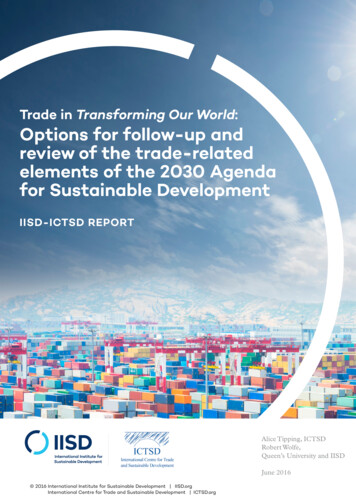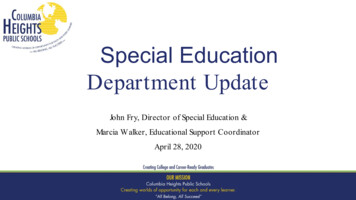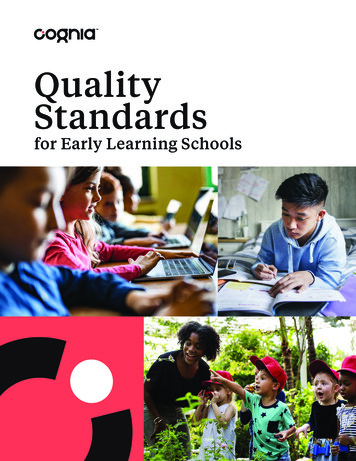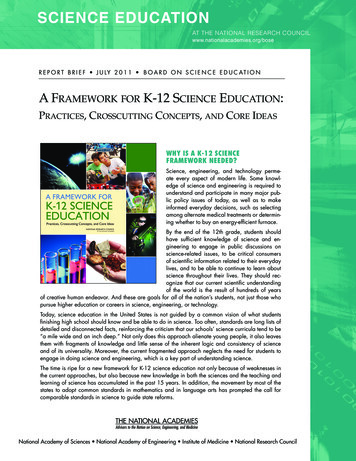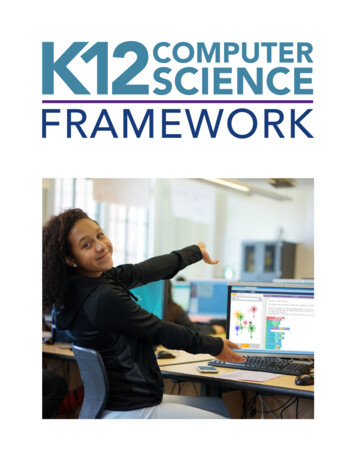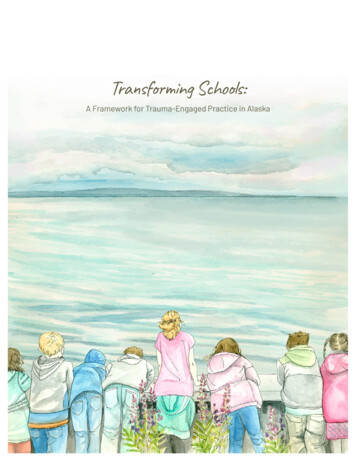
Transcription
Transforming Schools:A Framework for Trauma-Engaged Practice in Alaska
Sharon FishelState of Alaska Department of Education and Early DevelopmentAndrea “Akalleq”SandersFirst Alaskans InstituteHeather CoulehanAssociation of Alaska School Boards, Initiative for Community EngagementKonrad FrankAssociation of Alaska School Boards, Initiative for Community EngagementCONTRIBUTORSPatrick SidmoreAssociation of Alaska School Boards, Initiative for Community Engagement(Formerly Alaska Mental Health Board and Alaska Advisory Board on Alcoholismand Drug Abuse)Thomas AzzarellaAlaska Afterschool Network, Alaska Children’s TrustAnn RauschState of Alaska Department of Public SafetyCouncil on Domestic Violence and Sexual AssaultJosh ArvidsonAlaska Child Trauma Center, Anchorage Community Mental Health ServicesLori GrassgreenAssociation of Alaska School Boards, Initiative for Community EngagementWe would like to thank the dedicated community members and school staff working to improve the well-being andacademic outcomes of Alaskan children. Many contributed to the development of this document. A special thanks toschool counselors, educators, administrators, school nurses and school board members who contributed content andreviewed this framework throughout the state. A special thanks to community and school team reviewers in LowerYukon, Juneau, Ketchikan and Nome School District.More than 200 community members, school board members, school staff, counselors, nurses, and administratorsprovided content, reviewed or edited this document. Input was provided by attendees of workshops or full day sessions at the 2018 School Safety and Well-Being Summit, 2017 and 2018 School Counselors Conference, School Healthand Wellness Institute, Association of Alaska School Boards 2017 Trauma Informed Pre-Conference Day and others.Additional gratitude goes to Rebecca Braun for her editing services and Anne Bacinski at Spin.Space for the designof this document.Promoting wellness throughbehavior health care servicesACMHSAnchorage CommunityMental Health ServicesThis document was collaboratively developed and reproduction in accord with the fair use doctrine is encouraged. Any adaptations, publications,or public display of materials require partner credit and written permission from copyright holders. Please direct inquiries to Association of AlaskaSchool Boards or Alaska Department of Education and Early Development.All illustrations copyright 2019 by Kristin Link, KristinIllustration.com
Introduction51:11Deconstructing Trauma2:Relationship Building173:Policy Considerations234:293541Planning and Coordinationof Schoolwide Efforts5:Professional Learning6:Schoolwide Practicesand Climate7:478:53Skill InstructionSupport ServicesCultural Integrationand Community .gov10:Family Partnership11:Self-care 3
dCoordination ionand vicesSkillInstructionSchoolwidePractices andClimateAs Alaskans we are resilient and on the cutting edge of transforming schools together by supporting the wholestudent and integrating trauma engaged practices. This framework brings together lessons learned by school staffand community members within Alaska while integrating school-wide trauma-engaged approach to improve academicoutcomes and well-being for all students. Using stories, research, and best practices, this resource is designed for useby school-community teams seeking to make our schools a place of positive transformation and significant learningfor each student.4 Transforming Schools: a Framework for Trauma-Engaged Practice in Alaska
INTRODUCTION“Understanding my students’ stories has helped us bothto be more successful” -Alaska educatorSUMMARYUnderstanding the effects of childhood trauma transforms our understanding of what ourstudents need to succeed, and enables schools to helpbreak rather than perpetuate the cycle of trauma.In Our Schools: A Small Change with DeepImplicationsImagine standing just inside the front door of an elementary school at the start of a wintry Alaskan day. It’sdark and cold outside and each time a child comes in thewind blows just a little bit of snow in with them. Most ofthe children pass through the doors and go on to theirclassrooms; some stop to get breakfast if they haven’teaten. At 8 a.m. sharp, a bell rings, signifying the start ofschool. A few children continue to arrive, late for school COMMON PR ACTICEA few children continue toarrive after 8:00 am – late for school. The front office stafftells the children to line up – sometimes they are backedup out the door – while tardy slips are prepared for eachchild. It takes a few minutes to wait in line for a tardy slipand then it’s off to class with no time to get breakfast if theydidn’t get it at home. The child has to take the tardy slip toclass and present it to the teacher in front of her peers.T R A N S F O R M AT I V E P R A C T I C EA few childrencontinue to arrive after 8:00 am – late for school. The frontoffice staff greets each child: “I’m so happy you’re here.Have you had breakfast?” If not, the student heads downthe hall to get a quick breakfast. The children go to classwithout a tardy slip and are greeted warmly by the teacherand integrated into the classroom activities.A Change in ThinkingTardy slips are handed out to teach responsibility;the idea is that getting a tardy slip and having to presentit to the teacher is burdensome enough to change thebehavior of the child. In reality, not every child starts theday with support from an adult at home. By handing outtardy slips, children who are late to school take the blamefor not having the support systems other children rely ondaily. This isn’t the lesson most schools set out to teach.By contrast, transformative practice reflects a realization that, for the most part, arriving at school on timefor elementary school children is the responsibility ofparents or other adult caregivers. Some students get up,get dressed, fix breakfast, and get to school without thehelp of an adult. A positive, welcoming message from theschool is more helpful and productive than a tardy slip,and allows students to get to class more quickly.Introduction 5
Key Research FindingsA growing body of research indicates that students’life experiences deeply impact their academic, cognitive,and social-emotional development.An estimated two in three Alaskan children are exposedto traumatic experiences.1 Significant emotional stressand trauma during childhood affects Alaskans across racial, social, economic, and geofigure lines. Figure 1 showsthe percentage of Alaskan adults who report experiencingadverse childhood experiences (ACEs).Hundreds of studies have found that the more exposurea child has to adverse childhood experiences (ACEs), thehigher the child’s risk for poor educational, social, health,and economic outcomes in childhood and adulthood.Figure 2, based on Alaska research, illustrates the linkbetween increased exposure to childhood trauma and avariety of conditions that present challenges for both thelearner and the school.As figure 2 shows, children with four or more ACEs –i.e., significant childhood trauma – have 3 to 6 times therate of learning disabilities, repeating a grade, attentionproblems, and individual education plans than their peerswith no ACEs.These challenges leadtolowereducational attainment:Alaskan adults with four or more ACEs are half as likely tograduate from college as those with no ACEs, and morethan twice as likely not to complete high school. Childhoodtrauma reaches into our classrooms and impacts everyaspect of teaching and learning.There is hope. Studies have found that the negativeimpacts of childhood trauma can be reduced throughpositive experiences and relationships. A 2017 study finds,“Positive experiences and supportive relationships providethe buffering that allows children to withstand, or recover,from adverse experiences.” 2Schools have a unique role to play because schools arewhere families and students intersect with the broadercommunity. This framework explores ways schools canwork with students, families and communities to reducethe impact of trauma and help all students thrive.What is Alaska’s Transforming Schools Framework?The vision of this tool is to help Alaska schools andcommunities integrate trauma-engaged policies andpractices that improve academic outcomes and well-beingfor all students. Improving student outcomes requires usto support the whole child, and to understand how traumaimpacts a child’s ability to learn and thrive.1. Percentage of Alaskan Adults who Reported Individual ACEs by TypeEmotional Neglect15.8Physical Neglect11.1Incarcerated Family Member11.2Separation or Divorce31.8Witnessed Domestic Violence18.6Household Substance Abuse34.0Household Mental Illness21.3Emotional Abuse32.7Sexual Abuse15.9Physical Abuse18.305101520253035Source: 2014-2015 Alaska Behavioral Risk FactorSurveillance System, Section of Chronic Disease Prevention and Health Promotion, Alaska Division of PublicHealth, & Centers for Disease Control6 Transforming Schools: a Framework for Trauma-Engaged Practice in Alaska
2. Adverse Childhood Experiences (ACEs) Incidences Among Alaskan Students and Select OutcomesOutcomes0 ACEs4 or More ACEsIncrease from those with 0 to 4 ACEsLearning Disabilities6.2%23%3.6 times greaterAttention Deficit Disorder4.7%21%4.5 times greaterIndividual Education Plan7%27%3.8 times greaterRepeated a Grade2.9%16%5.4 times greaterSource: Child and Adolescent Health Management Initiative (2012). 2011-2012 National Survey of Children’s Health, U.S. Department of Health and Social Services, Analysis by the AlaskaMental Health Board.The tardy-slip scenario at the start of this chapterillustrates that when our schools are not trauma-engaged,we may adopt practices that compound the stresses onvulnerable children.3Conversely, when we understand trauma and stress,we can act compassionately and take steps that supportwellness and help students engage in learning. In the tardy-slip scenario, those steps were to make each child feelwelcome, to ensure each child is fed, and to eliminate thepotential negative peer attention or stigma of a tardy slip.This framework is a resource for Alaskans – educators,parents, and community members – who want to helpmake their schools a place of positive transformationfor all children.Trauma-InformedTrauma-informed communities and schools developa shared language to define, normalize, and address theimpact of trauma on students and school staff. They operate from a foundational understanding of the nature andimpact of trauma, coupled with the power of resiliency.Continuum of ChangeMost trauma-informed work moves along a continuumof change:Trauma-OrganizedTrauma-organized communities and schools are impacted by stress, avoidant of issues, and isolated in theirpractices, which can exacerbate the impacts of traumafor some students. When functioning in isolation, schoolscan be reactive rather than thoughtful, can magnifytrauma rather than offering an alternative to traumaticexperiences, can avoid or discount trauma rather thanacknowledging its prevalence, and can be run in an authoritarian manner rather than an authoritative manner.1Alaska Department of Health and Social Services. (2015) Adverse ChildhoodExperiences: Overcoming ACEs in Alaska.2Sege, R., et al. (2017) Balancing Adverse Childhood Experiences with HOPE(Health Outcomes of Positive Experience): New Insights into the Roleof Positive Experience on Child and Family Development, Casey FamilyPrograms.3McInerney, M. & McKlindon, A. (undated) Unlocking the Door to Learning:Trauma-Informed Classrooms & Transformational Schools. Education LawCenter.Introduction 7
Trauma-EngagedTrauma-engaged communities and schools go a stepfurther. They have policies, procedures, and supportservices that embed an understanding of trauma. Theirapproaches to learning and discipline are trauma-shieldingor trauma-reducing. They are reflective and collaborative,they promote a culture of learning, and they make meaningout of the past. They are also prevention-oriented andhave relational leadership.Transforming Schools: Creating trauma-engaged,safe, and supportive schools requires holistic change,and a mindset shift for students, administrators, schoolstaff, and community members.Relationships as the FoundationPositive relationships are essential for all of us to thrive.These relationships are central to success in trauma-engaged schools. The organization Trauma Transformedexplains:Trauma is overwhelming and can leave us feeling isolated or betrayed, which may make it difficult to trust othersand receive support. When we experience compassionateand dependable relationships, we re-establish trustingconnections with others that foster mutual wellness.4Developing a successful trauma-engaged systemrequires relationship-building every step of the way.Each key adult in a student’s life has a role in modelingpositive, healthy relationships to promote student healingand learning. Similarly, the relationships we build acrossschools, communities, and with families are critical forsupporting the whole child.Context for This WorkElders often share that communities across Alaskahave been healing, supporting and strengthening children,parents, and all community members for thousands ofyears. This tool builds on past and current work, integrating what we know about best practices with the uniquestrengths and circumstances of our communities, schools,and families in Alaska.For nearly two decades, organizations and communities across the state including behavioral health, publichealth, youth-serving organizations, tribal organizationsand non-profit organizations like the Association of AlaskaSchool Boards have been promoting resilience throughcommunity-based efforts.8Alaska public health and behavioral health departmentshave been a leader in researching and sharing informationabout adverse childhood experiences (ACEs), and havemade significant contributions to the understanding ofACEs, trauma, culturally responsive learning, and brainscience.This framework also builds on recent state-level efforts– the Alaska Safe Children’s Act and Alaska’s EducationChallenge. Alaska’s Education Challenge, introduced byGovernor Bill Walker in January 2017, brought Alaskanstogether to think deeply about our education system anddecide what an excellent education for every studentevery day looks like. Cultivating trauma-engaged schoolsemerged as one of the top three priorities for every stateschool board member.Historic and Systemic TraumaThere are special considerations for trauma and resilience in Alaska. Alaska’s history is key to understandingthe disproportionality of Alaska Native children with highACEs scores and high dropout rates, and the need forculturally specific trauma-engaged schools. As part ofthe colonial effort to gain control of lands, resources, andsouls, many Alaska Native children were forcibly removedfrom their homes and communities and sent hundreds orthousands of miles away to boarding schools establishedand run by the state, church and businesses. Many AlaskaNative children were physically, spiritually, emotionally,and sexually abused by those who had taken control of theirlives. Many were punished for speaking their languages.Our current systems often perpetuate policies that do notrecognize Alaska Native peoples’ culture, languages, andways of life or accommodate for the ongoing impact thishistorical trauma has created.Trauma also plays a major role in at-risk and specialpopulations, including children in foster care and thejuvenile justice system, LGBTQ children,5 children whosefamilies have recently immigrated from war-torn regions,and children living in areas of high poverty or crime. Transforming Schools: a Framework for Trauma-Engaged Practice in Alaska
Suggested StepsReflectionsSchools and districts looking to become moretrauma-engaged are most likely to succeed withthoughtful preparation. Tips for getting started:1. Develop a clear rationale and vision. Consider why this work matters, what your schooland community stand to gain through morethoughtful, trauma-engaged practice, anddevelop a vision for transforming your school,district, and community.2. Assess your community’s readiness. Districts need to assess their capacity to movetoward more trauma-engaged practices.Identify or develop the necessary infrastructure and supports at the administrative level.Districts also need to determine where theywant to start – district, school, classroom,community.3. Gain buy-in and trust through communication, collaboration, and commitment tosuccess. This work will not succeed and endure without broad participation and supportfrom teachers, administrators, families andcommunity members.4. Promote a culture of safety and respectfor this work. Childhood trauma, intergenerational trauma, and implicit bias can bedifficult to approach. Establish and maintainclear standards for respectful listening anddialog.XXWhat does childhood trauma look like in your community? How does it impact your schools?XXWhy is this work needed in your community?XXWhat is your community’s vision for transformingschools? What will success look like?XXWho can your schools partner with to help reachthe broader community?XXWho needs to be on board for this to work?XXWhat is needed to be ready to successfully undertake this work?Key TermsChildhood trauma: A negative event or series ofevents that surpasses the child’s ordinary coping skills.It comes in many forms and includes experiences such asmaltreatment, witnessing violence, or the loss of a lovedone. Traumatic experiences can impact brain developmentand behavior inside and outside the classroom.Adverse Childhood Experiences (ACEs): ACEs referto various negative experiences in childhood includingmedical and natural disasters experienced by childrenand youth. The original ACE list includes 10 categoriesof childhood stressors:XX Abuse: emotional, physical, sexual abuse5. Develop a common understanding of termsto establish and maintain respectful, constructive and open dialog while using thistool. For example, the term “historic trauma,”used in this document, may be called “untoldhistories” elsewhere.XXTrauma in household environment: substanceabuse, parental separation and/or divorce, mentally ill or suicidal household member, witnessingviolence, imprisoned household memberXXNeglect: abandonment, child’s basic physical and/or emotional needs unmet6. Expect setbacks. There will be mistakes andchallenges in this work. View them as opportunities to learn. This work requires ongoingcommitment and perseverance, resilienceand reflection – the same skills children needto grow and change.7. Use this framework as a resource. You donot need to work through the chapters sequentially; feel free to pick and choose. Likewise, not every suggested step or reflectionquestion will apply to all users. Take whatworks, and adapt it as needed.4Cordero, S. (2018) March Principle of the Month: Compassion andDependability, Trauma Transformed: A Program of East Bay Agency forChildren (blogpost).5Lesbian, gay, bisexual, transgender, and questioning (or queer)Introduction 9
Social-emotional learning (SEL): The process throughwhich children and adults acquire and effectively apply theknowledge, attitudes, and skills necessary to understandand manage emotions, set and achieve positive goals,feel and show empathy for others, establish and maintainpositive relationships, and make responsible decisions.Self-regulation: The ability to manage one’s emotionsand behavior in accordance with the demands of the situation. It includes being able to resist highly emotionalreactions to upsetting stimuli, to calm yourself down whenyou get upset, to adjust to a change in expectations, and10to handle frustration without an outburst. It is a set ofskills that enables children to direct their own behaviortowards a goal despite the unpredictability of the worldand our own feelings.Child well-being: A state of being that arises when achild’s needs are met, and the child has the freedom andability to meaningfully pursue their goals and ways of lifein a supportive, equitable setting now and into the future. Transforming Schools: a Framework for Trauma-Engaged Practice in Alaska
1D E C O N ST R U C T I N G T R AU M A“ Childhood trauma turns a learning brain into a surviving brain.”–Josh Arvidson, Director, Alaska Child Trauma CenterSUMMARYHigh levels of toxic stress impact thedevelopment of children’s brain wiring, impairing theirability to regulate, or control, their emotions, thoughts andbehaviors. Schools can help students learn self-regulationand can support positive brain development through awhole-school, whole-community approach.In Our Schools: Sarah’s StorySarah is a 13-year-old middle school student with average grades. One day Sarah starts a food fight in her schoolcafeteria. The mess leads to a negative interaction witha lunchroom monitor, and Sarah is unable to calm downand control her frustrations.COMMON PRACTICESarah is suspended fromschool for three days. She falls behind in her work andfeels angry and alienated from school.T R A N S F O R M AT I V E P R A C T I C EAn adult at theschool who fostered a relationship with Sarah learnedthat Sarah recently found out her mother was going tojail. Sarah’s school has been incorporating knowledge oftrauma’s impact on students and staff into their cultureand practices. The adult reports the situation to schooladministrators, and the school develops a plan to promoteaccountability and help Sarah develop the skills she is missing. These steps include in-school suspension, supportfrom a school counselor, outreach to Sarah’s family, andan opportunity for Sarah to repair relationships disruptedby her behavior in the cafeteria.Key Research FindingsThe brain goes through enormous development duringchildhood and adolescence in response to a person’senvironment and experiences.Understanding the biology of stress helps track thepathways from childhood stress to undesirable behaviorsand outcomes, and gives us insight into how we mightinterrupt those pathways and reduce harmful impacts.Chapter One: Deconstructing Trauma 11
Childhood is a Key Time for Brain DevelopmentFigure 3 represents the complexity of the brain’spathways at three stages of development. The earlyyears generate immensely complex wiring in responseto experiences. Around puberty a pruning occurs wherethe most frequently used pathways are hardened andthose least used are discarded. Schools are in a positionto reinforce positive brain development and significantlymitigate problematic pathways developed from earlytraumatic experiences.It is possible to “rewire” the brain at any age, but it iseasiest in childhood.3. Brain Wiring Through ChildhoodAt BirthAt 7 Yearsof AgeThe Center on the Developing Child at Harvard University describes three types of stress:XX Positive stress response is a normal and essentialpart of healthy development, characterized bybrief increases in heart rate and mild elevations inhormone levels. For example, the first day at a newschool might trigger this type of stress response.XXTolerable stress response activates the body’salert systems to a greater degree as a result ofmore severe, longer-lasting stressors, such as theloss of a loved one, a natural disaster, or a frightening injury. If the activation is time-limited andbuffered by relationships with adults who help thechild adapt, the brain and other organs recoverwithout lasting damage.XXToxic stress response can occur when a child experiences strong, frequent or prolonged perceivedthreats or danger – such as physical or emotional abuse, chronic neglect, caregiver substanceabuse or mental illness, exposure to violence,or the accumulated burdens of family economichardship – without adequate adult support. Prolonged activation of the stress response systemscan disrupt the development of brain architecture and other organs, and increase the risk forstress-related disease and cognitive impairment.At 15 Yearsof AgeSource: Adapted from Corel, JL. The postnatal development of the humancerebral cortex. Cambridge, MA: Harvard University Press; 1975.12 Transforming Schools: a Framework for Trauma-Engaged Practice in Alaska
4. Typical conditionsGraphics 4-6: Source: Arvidson, J, et al. 2011, Trauma 101: UnderstandingTrauma in the Lives of Children and Adults.5. Alarm SystemGraphics 4-6 illustrate how repeated stress can leadto troublesome cognitive habits.Under typical conditions, we move through our livestaking in the world, interpreting what we experiencethrough our senses, processing and evaluating what wewant to do, and finally planning and acting on all thoseinputs.When we run into a stressor or potentially dangeroussituation, our brain, which is constantly scanning for“trouble,” switches to a stress response system. The morecontemplative aspects of our usual response are cut out –and instead flight, fight or freeze responses are activated.These responses get us out of trouble fast, and are veryeffective for situations requiring immediate action.When we are exposed to repeated or toxic levels ofstress, the “express route” becomes the default responsefor most events. Being on this kind of alert in all settingsinhibits thoughtful decision-making and hurts performance in school and in life.When the developing brain is chronically stressed,it releases hormones that shrink the hippocampus, anarea of the brain responsible for processing emotion andmemory and managing stress. Recent studies suggestthat increased exposure to adverse childhood experiences results in less gray matter in the brain, including theprefrontal cortex, an area related to decision-making andself-regulatory skills, and the amygdala, or fear-processingcenter.1 In other words, childhood trauma may damagethe developing brain, causing problems with learning,decision-making, and managing emotions6. Express Route1Nakazawa, D.J. (2016) 7 Ways Childhood Adversity Changes a Child’s Brain,ACEs Too High News.Chapter One: Deconstructing Trauma 13
There is hope. Just as negative experiences canharm the brain, positive interventions can help repairdamaged neural pathways.2 Active interventions can anddo change the life course for individuals exposed to highchildhood stress levels. A review of research literaturepoints to self-regulation3 – or learning to control andregulate one’s emotions – as the key to mitigating theimpacts of stress and trauma.Schools Have a Key RoleSchools have a critical role in helping build and reinforce neural pathways that support resilience, good decision-making, positive relationships, and lifelong learning.Schools connect children to concepts about numbers,sorting and words, and help children understand how tointeract with others and manage their own thoughts andfeelings. The impacts of this foundational work stretchacross a child’s lifetime.How should schools approach this task? Surveys ofAlaska secondary school students suggest some startingpoints. Alaska high school students who believe teacherscare about them and that their schools have clear ruleshave better grades and participate less often in a host ofdangerous activities. These findings support researchon the importance of relationships and structure – in theform of clear, fair, and consistent rules – to help childrenmanage and overcome the impacts of trauma and difficultexperiences.4Classroom ConnectionProvide warm and responsive relationships in schoolto all students. This includes linking words and actionsto unconditional positive regard for students.The physical environment should be safe bothphysically and emotionally for students. Consistent,predictable routines as well as clear goals for behaviorwith well-defined logical consequences for negativebehavior are essential.Self-regulation skills should be a part of the schoolexperience through modeling, instruction and opportunities to practice. Just like math skills, self-regulationskills take time to develop and strengthen.14To help children and youth develop and sustain self-regulation skills, adults need to understand trauma and modelspecific skills and interventions. Key skills for studentsand adults are self-awareness, accessing supportive relationships, and self-regulation amidst what can be a verydemanding school day. Self-care, addressed in anotherchapter, is also critical.This work is not easy given the many demands onteachers and school staff. There needs to be a structureof support and understanding within the broader schooland community.Trauma-Engaged Practice in Action: Sarah’s StoryThe story at the start of this chapter illustrates thattroubling in-school behaviors may have their origin in familystress. Sarah faces an overwhelming change to her familystructure. Her mother’s impending incarceration is likelynot the only difficulty Sarah has faced.In an ideal world, Sarah would tell an adult, “I am verystressed and need help,” and adults in school would havethe skills and time to help her. But Sarah doesn’t have theskill to take that step, and instead communicates throughan outburst of inappropriate behavior.As Sarah’s story shows, stress and trauma impactchildren’s ability to regulate their emotions and thoughts.This is true for adults too. Behavior is a form of communication and high levels of stress can overwhelm us. Atrauma-engaged approach focuses on accountability andskill-building so Sarah can learn to manage her stress ina healthier way. Steps might include:XX Let Sarah finish her school day in an alternativesetting. Rather than send Sarah out of school,provide a safe place for her to gain control of heremotions and assess
Significant emotional stress and trauma during childhood affects Alaskans across ra - cial, social, economic, and geofigure lines. Figure 1 shows the percentage of Alaskan adults who report experiencing adverse childhood experiences (ACEs). Hundreds of studies have found that the more exposure a child has to adverse childhood experiences (ACEs .





